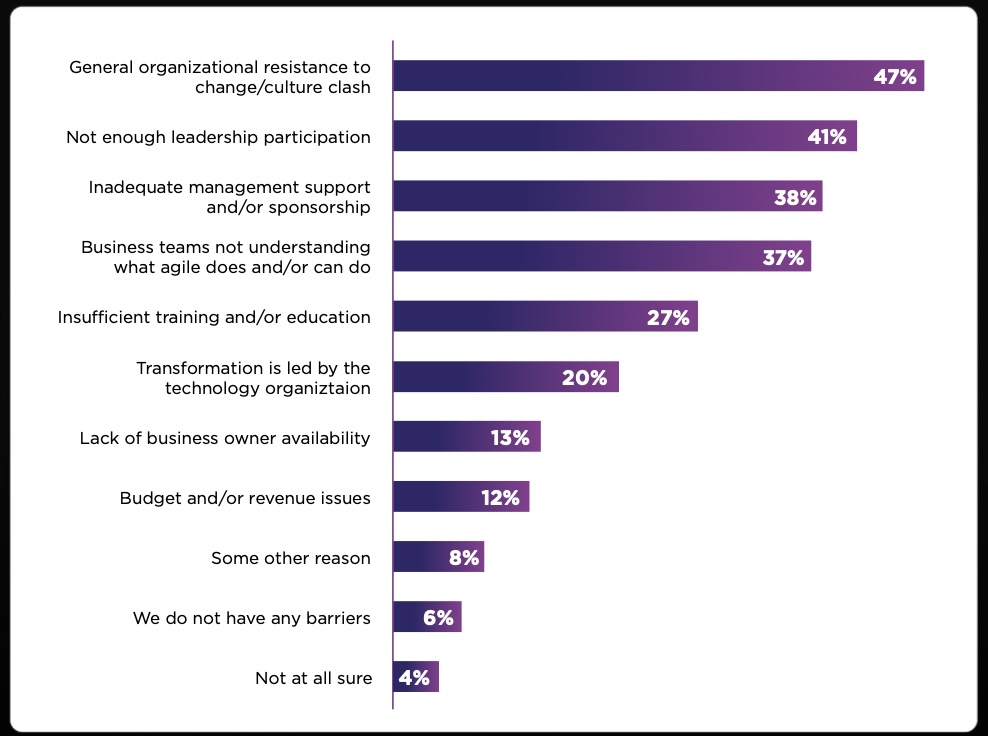
The 17th State of Agile report, which claims to be the longest-running survey on the topic, states that “Agile is having difficulty adapting,” as medium and large size organizations are “less satisfied with what Agile can do for them.”
Only 44 percent of respondents reported that Agile is working somewhat or very well, while a little more than a quarter said that it is not working well and others gave no clear response.
According to the report, Agile is most successful at small companies. “Those in small companies are more likely than those in medium and large ones to say they are satisfied [with Agile],” the report states, and “74 percent of small companies (versus 62 percent at large companies) said at least 50 percent of their applications were delivered on time and with quality”.
A key problem, which will not be a surprise to developers, is that “the business side is very slow to embrace Agile. Almost half of survey takers pointed to a generalized resistance to organizational change or culture class as the reasons why the business side is not embracing Agile, up 7 points from 2022.”

Those represented include 30 percent working at companies with more than 20,000 employees, 29 percent at organizations with 1,000 or fewer, and the rest in between. Nearly half were in North America and a quarter from Europe. Notably, one-third of respondents are Agile coaches and 14 percent Scrum masters, showing high engagement with the survey from the Agile community. Others are involved elsewhere in the development process. The survey is sponsored by Digital.ai, founded in 2020 by a series of acquisitions including that of CollabNet Inc, a company focused on the software development process since its foundation in 1999.
The Agile Manifesto was published in 2001 by a group of well-known developers and has been a huge influence on best practice development methodology, supporting incremental and collaborative development versus an inflexible process of requirements gathering followed by coding. One of its key principles is “Responding to change over following a plan.” Although focused on software development, Agile is more about collaboration than technology, explicitly favouring “individuals and interactions over processes and tools.” It is easy to see how this might unravel in large, hierarchical organizations or those which lack an open and communicative culture.
Scrum is a specific Agile methodology and used by 63 percent of Agile teams, according to the report, which also states that Scrum has been the most popular Agile methodology since 2006 when the survey was first conducted.
That said, even Scrum has many variants and the survey states that “the Agile landscape continues to be very fragmented.” 22 percent of survey respondents said that “we don’t follow a mandated framework” and 12 percent that “we created our own enterprise Agile framework.”
Asked how DevOps in their organization could most be improved, the top choice by some margin was “end to end visibility and traceability from business initiative through development, test and deployment to end users,” ticked by 44 percent of respondents. This points to lack of collaboration, which also happens to be at the heart of what Agile is all about. It seems that organizations have a desire to use Agile because of the benefits it promises, but are unable to embrace it fully because of other factors.
“Where does Agile go from here?” ask the researchers, concluding that “enthusiasts, skeptics, and everyone in between need to come together to reconsider the role Agile can and should play in modern software development.”
Perhaps, but if organizations are culturally resistant to the collaborative principles of Agile, it is unlikely that a modified approach will work any better.
